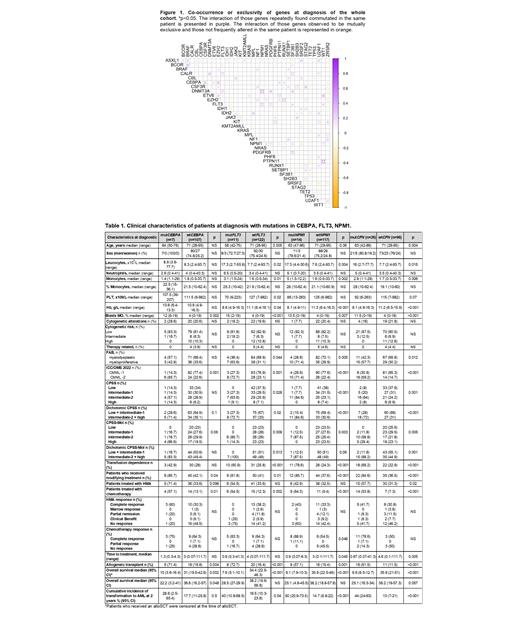CMML is rarely associated with AML typical mutations such as NPM1, FLT3, CEBPA and IDH1/2 (mutAML-CMML). It is unknown what its clinical meaning is and if its presence should change our management into an AML-type treatment. The aim was to describe the characteristics, prognosis and treatment of mutAML-CMML patients.
We studied 83 CMML patients of Hospital Clinic diagnosed between 1998-2022, with Next Generation Sequencing (NGS). We included 53 patients with mutAML-CMML from other institutions.
We identified 31 patients with mutated IDH2 (all c.419G>A p.(Arg140Gln)), 13 with IDH1, 14 with NPM1,7 with CEBPA (4 bZIP) and 11 with FLT3 (3 FLT3-ITD and 7 FLT3-TKD: 6 TKD1 and 2 TKD2 variants, all different from p.(Asp835Tyr) except one).
Patient characteristics and outcome of the group with mut IDH1/2 was not significantly different from wt IDH.
Those patients with mut NPM1, FLT3 and/or CEBPApresented adverse characteristics and worse prognosis. Therefore, we grouped the patients with these mutations into a category named mutCFN (n=26) (Table 1). The mutCFN incidence in our series was 9%.
The mutCFN patients (n=26) vs wtCFN (n=96) were younger (63 vs 71 years, p=0.004), had more leucocytes (16 vs 7.7x10 9/L, p=0.015), monocytes (2.9 vs 1.7x10 9/L, p=0.006), anemia (9.1 vs 11.2 g/L, p<0.001) and bone marrow blasts (11.5 vs 4%, p<0.001). They belonged more frequently to myeloproliferative variant (57.7 vs 30.2%, p=0.012), CMML-2 (69.2 vs 14.7%, p<0.001), high risk CPSS and CPSS-Mol (72 vs 31%, p<0.001; 88.2 vs 44.9%, p=0.001). They showed more transfusion dependence (69.2 vs 22.9%, p<0.001). Co-mutational representation is shown in Figure 1. mutCFN patients have a different co-mutational pattern from wtCFN with more frequently mutated DNMT3A (42.9 vs 6.3%, p<0.001), SF3B1 (15.8 vs 2.3%, p=0.04), WT1 (10 vs 0%, p=0.03), and less TET2 (24 vs 58.3%, p=0.003) .
mutCFN patients received treatment more frequently than wtCFN (84.6 vs 36.5%, p<0.001) and earlier (0.97 vs 4.6 months, p=0.005). They were more frequently treated with chemotherapy (53.8 vs 7.3%, p<0.001) and alloSCT (61.5 vs 11.5%, p<0.001). The median follow-up was 9.3 years (95% CI, 8-11). The 2-year cumulative incidence of AML (CIR-AML) transformation was higher in mutCFN patients (44% vs 13%, p<0.001) and overall survival (OS) was shorter (25 vs 38 months, p=0.057). Besides, when those who received and alloSCT were censored at time of alloSCT, mutCFN showed an inferior survival (9.6 vs 35.7 months, p<0.01). Multivariate analysis confirmed mutCFN as an adverse prognostic factor independent of age and CPSS-Mol (HR 2.42, IC 95% 1.23-4.76, p=0.011). Because CFN mutation showed independent prognostic value not captured by CPSS-Mol, we added to CPSS-Mol 1 point if patient had mutCFN. We derived a modified CPSS-Mol-CFN score and identified five groups with different median OS of 85 (95% CI, 54-117) vs 74 (95% CI, 53-94) vs 40 (95% CI, 17-63) vs 22 (95% CI, 11-33) vs 15 (95% CI, 5-25) months, p<0.001with a better predictive capacity than CPSS-Mol (C-index 0.66 vs 0.64).
Nowadays, there is no consensus between the two recent 2022 ICC and WHO classifications, but the identification of NPM1 or CEBPA mutations in cases of CMML could define AML. We analysed the group of patients who harboured bZIP- CEBPA or NPM1 mutations (“mutCN”) (n=17) and we found that these patients retained its chemosensitivity (90%CR) and those treated with chemotherapy had better OS (27 vs 9 months, p<0.001).
10 mutCFN patients received alloSCT with a median OS post-alloSCT of 21 months (95% CI, 16-26) and a 2year-CIR-AML of 37.5% (95% CI, 15-61). 5 patients received targeted therapy for a post-transplant relapse: 3 received sorafenib after a molecular relapse with prolonged responses and 2 received an IDH inhibitor, one of them persisting with a complete response after 4 years.
We analyzed 5 paired samples (diagnostic CMML-AML transformation). All of the AML related mutations were retained at AML transformation and emerged new mutations in genes of signaling ( FLT3, NRAS), transcription ( RUNX1, CEBPA) and splicing ( STAG2) pathways.
Independently of CPSS-Mol, mutCFN CMML patients have a different profile, closer to AML and with worse prognosis. They could benefit from more aggressive AML-treatment based on chemotherapy and alloSCT when possible. Interestingly, some patients may benefit from approved targeted therapy for AML
FinancingISCIII PI19/01476 PI22/01660, co-financed EU, Emili-Letang HCPB
Disclosures
Jimenez-Vicente:Pfizer: Other: Travel Grants; Abbvie: Other: Speaker, Travel Grants. Martínez-Roca:Janssen: Other: travel grants; Takeda: Honoraria, Other: travel grants; Roche: Honoraria, Other: travel grants; Kite: Honoraria, Other: travel grants; Abbvie: Honoraria, Other: travel grants; BMS: Honoraria, Other: travel grants; Gilead: Other: Travel grants. Diez-Campelo:Novartis: Consultancy, Honoraria, Membership on an entity's Board of Directors or advisory committees; BMS/Celgene: Consultancy, Honoraria, Membership on an entity's Board of Directors or advisory committees, Other: Advisory board fees; Gilead Sciences: Other: Travel expense reimbursement; GSK: Consultancy, Membership on an entity's Board of Directors or advisory committees. Esteve:Kronos Bio: Research Funding; Pfizer: Research Funding; Gilead: Consultancy; Abbvie: Consultancy; Jazz Pharmaceuticals: Consultancy, Research Funding; Astellas: Consultancy. Díaz-Beyá:Bristol Myers Squibb: Consultancy, Honoraria; Abbvie: Consultancy, Honoraria; Astellas: Consultancy, Honoraria; Jazz Pharma: Consultancy, Honoraria; Takeda: Consultancy, Honoraria; Novartis: Consultancy, Honoraria.


This feature is available to Subscribers Only
Sign In or Create an Account Close Modal